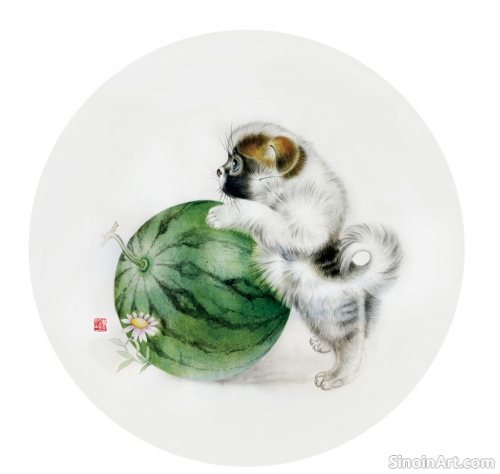Gongbi and the Use of Stippling and Pointillism Techniques
|
While Gongbi painting is primarily associated with fine linework and smooth color washes, artists also occasionally incorporate stippling and pointillism techniques to create a specific visual effect or suggest texture. These techniques, often involving the application of small dots or points of color, add another layer of complexity to the art form. The addition of these techniques creates a visual texture that sets the art apart.  The use of stippling and pointillism techniques in Gongbi is often subtle and controlled, rather than the bold and sweeping approach often seen in Western art forms. The dots of color are typically small and carefully placed, and are meant to work with the other elements of the piece.  The precise application of stippling and pointillism techniques in Gongbi often helps to create a sense of texture, simulating the roughness of a surface or the dappled effect of light filtering through leaves. The careful placement of the dots is used to create a visual texture that enhances the realism of the scene.  The use of these techniques is often reserved for specific areas within the painting where the artist wishes to draw particular attention or add visual complexity. The areas using these techniques are usually smaller and serve to emphasize a specific aspect of the work. These techniques often are used to highlight specific textures that would otherwise be difficult to portray. The techniques allow the artist to more clearly define the texture of specific objects or surfaces within the work. While not a traditional part of Gongbi, stippling and pointillism offer contemporary artists an opportunity to experiment with new techniques and expand the visual language of the art form. The addition of these techniques adds another way for contemporary artists to explore and push the boundaries of the art form. |
Tag : Stippling in art, pointillism, texture techniques, Gongbi brushwork, dot techniques
Related information
- Commissioning a Gongbi Painting: What You Need to Know
- The Influence of Western Art on Contemporary Gongbi Painting
- Collecting Gongbi: Insights and Considerations for Art Enthusiasts
- Gongbi Painting and the Depiction of Waterfalls and Streams
- Gongbi and Personal Expression: The Artist's Voice
This article provides a guide for those interested in commissioning a Gongbi painting, highlighting the importance of clear communication, artist selection, understanding the process, setting realistic timelines, and managing budget expectations.
This article explores the influence of Western art on contemporary Gongbi painting, highlighting the adoption of new perspectives, compositions, materials, techniques, and themes, and how these influences have created a unique hybrid style.
This article provides insights for art enthusiasts interested in collecting Gongbi paintings, focusing on the importance of brushwork quality, authenticity, subject matter, composition, and proper care for these delicate artworks.
This article explores the depiction of waterfalls and streams in Gongbi painting, highlighting the techniques used to capture the flow, movement, and reflective qualities of water, and how these works demonstrate a mastery of technique and appreciation for nature.
This article focuses on Gongbi painting as a vehicle for personal expression, highlighting how artists use choices in subject matter, color, composition, and overall tone to convey their unique perspectives and artistic visions within the traditional art form.